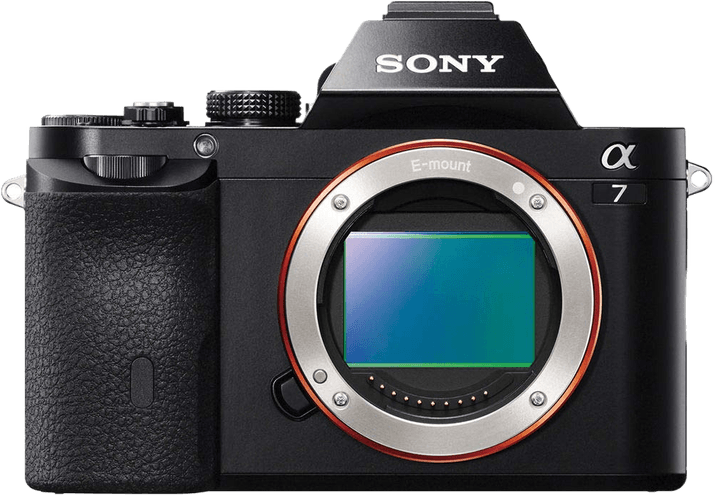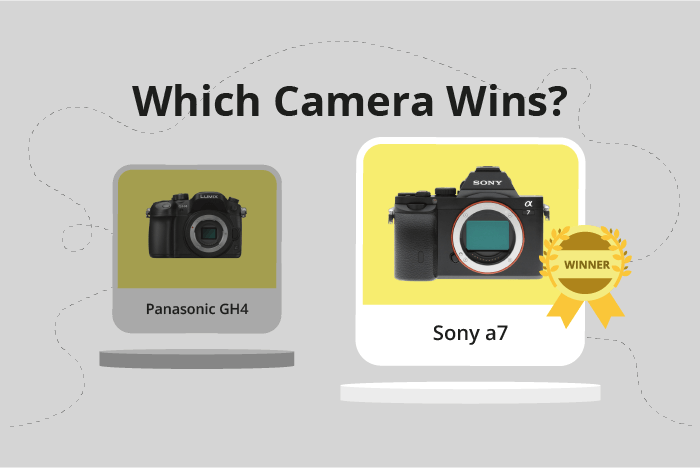Panasonic Lumix DMC-GH4 vs Sony a7 Comparison
Panasonic Lumix DMC-GH4

Sony a7

The Sony a7 outperforms the Panasonic Lumix DMC-GH4 with a score of 63/100 compared to 58/100. Both cameras are mirrorless and were launched in 2013-2014 at a price of $1700. They share similarities in size, with the GH4 measuring 133 x 93 x 84mm and the a7 at 127 x 94 x 48mm.
The GH4’s advantage lies in its slightly larger dimensions, which may provide better grip and handling. However, the a7 is lighter, weighing 474g compared to the GH4’s 560g, making it more portable for photographers on the go.
Considering these factors, the Sony a7’s higher score and lighter weight make it the preferable choice for most users, while the Panasonic Lumix DMC-GH4 may suit those who prioritize handling and grip.
Panasonic Lumix DMC-GH4 vs Sony a7 Overview and Optics
The Sony a7 emerges as the winner in the optics comparison with a score of 70/100, while the Panasonic Lumix DMC-GH4 scores 52/100. Both cameras share certain specifications, such as having a CMOS sensor type, no image stabilization, and similar processors – the Venus Engine IX for the GH4 and the Bionz X for the a7.
The Sony a7 outperforms the GH4 in several aspects. It has a higher megapixel count of 24 compared to the GH4’s 16, allowing for more detailed images. The a7 also boasts a superior DXOMARK sensor score of 90, as opposed to the GH4’s score of 74, which contributes to the camera’s better overall image quality. Additionally, the a7 features a full-frame sensor size and a 3:2 aspect ratio, further enhancing its imaging capabilities.
On the other hand, the Panasonic Lumix DMC-GH4 excels in shooting speed, capturing 12 frames per second compared to the Sony a7’s 5 frames per second. This makes the GH4 more suitable for capturing fast-moving subjects. Moreover, the GH4 uses a Micro Four Thirds sensor size and a Micro 4/3 lens mount, which allows for a wider selection of lenses and a more compact camera body.
Taking these factors into account, the Sony a7 demonstrates superior optics performance with its higher megapixel count, better sensor score, and full-frame sensor size, making it an ideal choice for photographers seeking high-quality images. However, the Panasonic Lumix DMC-GH4’s faster shooting speed and versatile lens options may appeal to those prioritizing action photography and portability.
Panasonic Lumix DMC-GH4 vs Sony a7 Video Performance
The Panasonic Lumix DMC-GH4 outperforms the Sony a7 in video capabilities, scoring 70/100 compared to the Sony a7’s 56/100. Both cameras share some common specifications, such as the ability to record high-quality video and capture stunning visuals. However, the differences in their video capabilities make the Panasonic Lumix DMC-GH4 the superior choice for videographers.
The Panasonic Lumix DMC-GH4 has a maximum video resolution of 4K, with dimensions of 4096 x 2160, while the Sony a7 only offers Full HD resolution, with dimensions of 1920 x 1080. This means that the Panasonic Lumix DMC-GH4 can capture more detailed and crisp footage, making it a better option for those seeking professional-grade video quality. Additionally, the Panasonic Lumix DMC-GH4 has built-in time-lapse functionality, allowing users to create captivating time-lapse videos without needing additional equipment or software.
On the other hand, the Sony a7 has a higher maximum video frame rate of 60fps, compared to the Panasonic Lumix DMC-GH4’s 24fps. This higher frame rate allows for smoother video playback, making it a better option for those who prioritize smoothness over resolution. However, the lack of built-in time-lapse functionality in the Sony a7 makes it less versatile compared to the Panasonic Lumix DMC-GH4.
Taking into account the differences in video capabilities, the Panasonic Lumix DMC-GH4 emerges as the better choice for videographers who prioritize high-resolution footage and built-in time-lapse functionality. On the other hand, the Sony a7 may be more suitable for those who prioritize smooth video playback, despite its lower resolution and lack of time-lapse functionality.
Panasonic Lumix DMC-GH4 vs Sony a7 Features and Benefits
The Panasonic Lumix DMC-GH4 wins in the feature comparison with a score of 70/100, while the Sony a7 scores 57/100. Both cameras share a screen size of 3 inches and have flip screens, which are useful for shooting from different angles and for capturing self-portraits. Neither camera has GPS, but both offer WiFi connectivity for transferring images and remote control, making it convenient to share and manage photos.
The Lumix DMC-GH4 has a touchscreen, which is absent in the Sony a7. This feature allows users to navigate menus and change settings quickly, as well as to focus on a subject by simply tapping the screen. The GH4’s screen resolution is 1,036,000 dots, which is slightly lower than the a7’s screen resolution of 1,230,000 dots. However, the presence of a touchscreen in the GH4 outweighs the difference in screen resolution.
The Sony a7 has a higher screen resolution, providing a clearer and more detailed display for reviewing images and adjusting settings. However, it lacks a touchscreen, which makes navigating menus and changing settings slower compared to the GH4.
Considering the features, the Panasonic Lumix DMC-GH4 is the better choice due to its touchscreen and overall higher feature score. The Sony a7 has a slight advantage in screen resolution, but it does not outweigh the benefits provided by the GH4’s touchscreen. Both cameras offer similar screen sizes, flip screens, and WiFi connectivity, making them suitable for various shooting situations.
Panasonic Lumix DMC-GH4 vs Sony a7 Storage and Battery
The Panasonic Lumix DMC-GH4 outperforms the Sony a7 in storage and battery with a score of 60/100, compared to the Sony’s 21/100. Both cameras accept SD, SDHC, and SDXC memory cards, but the Lumix GH4 has two memory card slots, while the Sony a7 only has one. Additionally, the Sony a7 accepts Memory Stick Pro Duo and Pro-HG Duo cards.
The Lumix GH4 has a longer battery life, allowing for 500 shots per charge, while the Sony a7 manages 340 shots. The GH4 uses a DMW-BLF19 battery, while the a7 uses an NP-FW50 battery. Neither camera offers USB charging.
The Lumix GH4’s advantages in storage and battery life make it the superior choice in this comparison. The Sony a7’s additional memory card compatibility is a minor advantage, but it does not outweigh the benefits of the GH4’s longer battery life and dual memory card slots.
Alternatives to the Panasonic Lumix DMC-GH4 and Sony a7
Are you still undecided about which camera is right for you? Have a look at these popular comparisons that feature the Panasonic Lumix DMC-GH4 or the Sony a7:

